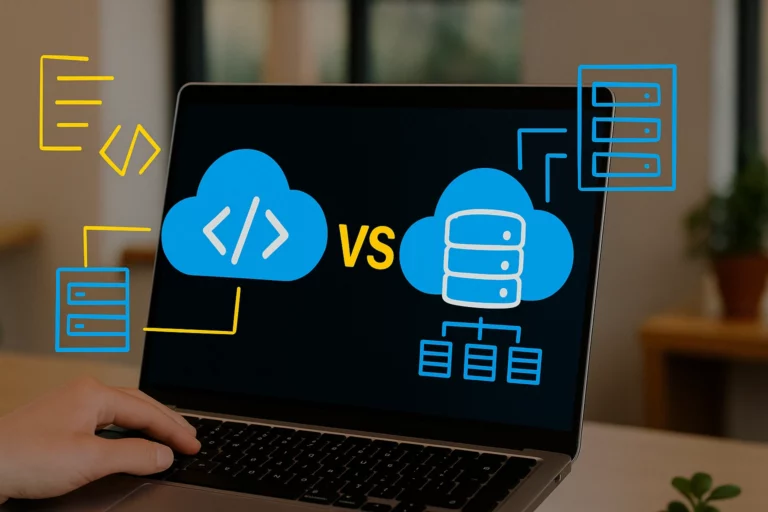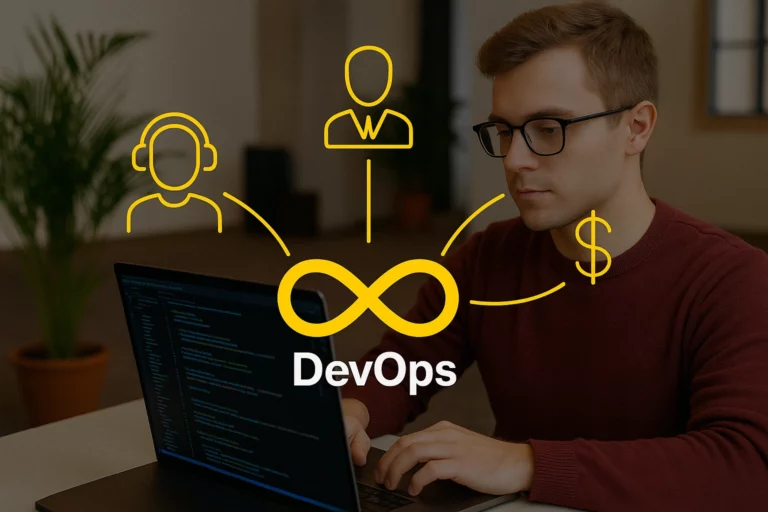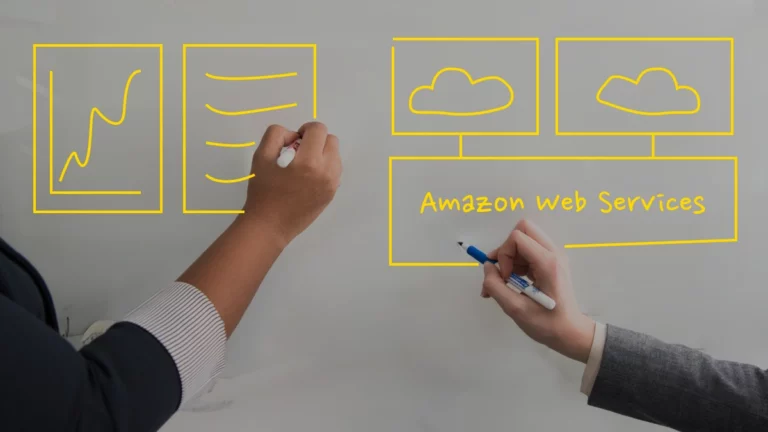DevOps vs NoOps Explained: What’s Better For Your Project
- What Is DevOps
- What Is NoOps
- NoOps vs DevOps: The Key Differences
- How NoOps Can Improve Operational Efficiency and Reduce Costs
- Can DevOps & NoOps Coexist within the Same Organization?
- Challenges of Transitioning from DevOps to NoOps
- What Technologies Support the Implementation of NoOps?
- Security Concerns When Adopting NoOps and Solutions
- What’s The Future of NoOps in Software Development?
As businesses increasingly adopt cloud technologies and automation, traditional operational models are being reimagined. DevOps has long been the gold standard for agile, collaborative IT workflows that drive innovation. However, this approach is now challenged by a growing trend of NoOps.
NoOps are pushing the boundaries of automation to the point where human intervention in routine operations is minimized – or even completely eliminated. This radical shift raises important questions. Can automation fully replicate the strategic insights of traditional DevOps? What are the risks associated with giving up direct control over IT processes? How will these changes impact long-term operational efficiency and software development? And is there a hybrid solution that can possibly give you the best of two worlds?
Starting with the basics, we’re going to explore NoOps and DevOps, compare their key benefits and core challenges for dedicated development teams – looking into how automation is reshaping workflows, along with the strategic implications for businesses looking to scale efficiently while managing costs.
What Is DevOps
DevOps integrates Development and Operations teams to streamline the software development lifecycle. It’s built around automation, Continuous Integration / Continuous Delivery (CI/CD), and rapid iteration. By breaking down silos between developers and operations staff, this approach promotes a culture of shared responsibility and enhanced communication. It leads to faster, more reliable software releases and improved system stability.
CI enables developers to merge code changes frequently while running automated tests, which helps in quickly identifying and resolving issues. CD takes this further by automating the deployment process, ensuring that software updates are released quickly, consistently, and with reduced risk of human error. This leads to a more agile, flexible, and process of development. In addition, the integration of monitoring and feedback loops means that any issues in production are addressed on the go.
| Benefits of DevOps | Limitations of DevOps |
| Fast Releases. Accelerates deployments and releases through automation and Continuous Integration pipelines. | Complex Implementation. Requires a significant shift facing resistance from teams used to traditional methods. |
| Collaboration. Breaks down silos between development and operations for better communication and teamwork. | Initial Cost & Effort. Can demand substantial initial investment in tools, training, and management. |
| Better Quality. Reduces errors and improves overall software quality with continuous testing and integration. | Complexity. Transitioning to a full DevOps operating model can be complex, especially for large projects. |
| Scalability & Flexibility. Enables dynamic scaling and faster adaptation using cloud and containerization. | Tool Overload. Can sometimes lead to integration issues and require extensive configuration efforts. |
| Proactive Monitoring. Drives quick issue resolution and system improvements with continuous feedback loops. | Security Risks. Increased automation might introduce new security vulnerabilities if not managed properly. |
What Is NoOps
NoOps is focused on achieving a fully automated infrastructure that minimizes or can even eliminate the need for traditional operations teams. Shifting the responsibility to automation technologies, the entire app lifecycle of NoOps, including deployment, scaling, and maintenance, is managed through automated pipelines and self-regulating systems. Cloud providers and advanced orchestration tools enable businesses to provision resources and manage services with minimal human intervention.
NoOps is supported by modern technologies such as Infrastructure as Code (IaC), AI-driven monitoring, and serverless architectures. No manual oversight is required for routine traditional IT operations. This allows the dev team to focus on building features and adding business value. This approach can be particularly effective if you have standardized, predictable workloads where automation can reliably manage software operations. Moreover, it can offer significant cost savings and even faster deployment cycles.
| Benefits of NoOps | Limitations of NoOps |
| Even Faster Releases. Automation further reduces manual tasks, speeding up the release cycle. | More Complex Implementation. Requires significant upfront investment in automation tools and training. |
| Cost Reduction. Minimizes the need for dedicated operations personnel, lowering overhead costs. | Limited Flexibility. Not all operational tasks can be fully automated, particularly in complex environments. |
| Consistency & Reliability. Automated processes ensure uniform deployments and reduce human error. | Greater Tool Overload. High reliance on specific automation tools / cloud providers leads to vendor lock-in. |
| Enhanced Scalability. Cloud-based automation allows for dynamic resource scaling, minimal intervention. | Reduced Human Oversight. Critical issues or exceptions may be potentially overlooked without human monitoring. |
| Improved Efficiency. Streamlined operations increase overall system responsiveness and uptime. | New Security Risks. Over-reliance on automation may expose security vulnerabilities if not managed correctly. |
NoOps vs DevOps: The Key Differences
Businesses are continually looking for ways to streamline IT operations and accelerate software deployment. While DevOps and NoOps offer different approaches to achieving these objectives – their focus, goals, and operational requirements differ significantly.
Focus and Philosophies
Operations in DevOps are centered on fostering collaboration between development and operations teams. It emphasizes breaking down silos to ensure that both groups work together throughout the software development lifecycle. The approach is human-driven, with continuous communication, iterative feedback, and a shared responsibility for both software delivery and underlying infrastructure stability.
In contrast, NoOps goes for a fully automated IT environment. Its focus is on eliminating, or at least minimizing, the need for an operations team by leveraging advanced automation tools, cloud-native services, and Infrastructure as Code (IaC) practices.
Operational Goals
DevOps emphasizes creating a smooth, collaborative workflow that accelerates release cycles while maintaining high standards of quality and reliability. DevOps allows developers to focus on CI / CD, ensuring that code changes are regularly tested, integrated, and released with minimal disruption.
NoOps takes on reducing human involvement in routine operational tasks. By automating processes such as deployment, scaling, monitoring, and even incident management, NoOps seeks to achieve faster, more consistent operations with reduced overhead. However, it also relies on robust automation frameworks and self-managing systems, which can introduce challenges in handling unexpected issues that will still require human intuition.
Requirements and Skill Sets
DevOps requires a balanced mix of technical expertise and soft skills. Teams must be proficient not only in coding and automation tools but also in communication, problem-solving, and teamwork. DevOps relies on tools for collaboration, CI/CD, and monitoring – such as Jenkins, Git, Docker, Kubernetes, and various cloud platforms.
In contrast, NoOps is built on the premise of an automated infrastructure where essential tasks are managed by the system itself. For teams, key requirements include mastery of automated deployment scripts, AI-driven monitoring tools, and cloud services that offer self-service functionalities. While NoOps can significantly reduce operational costs and simplify processes, it might not be suitable for all environments – particularly those that require complex decision-making or have variable / unpredictable workloads.
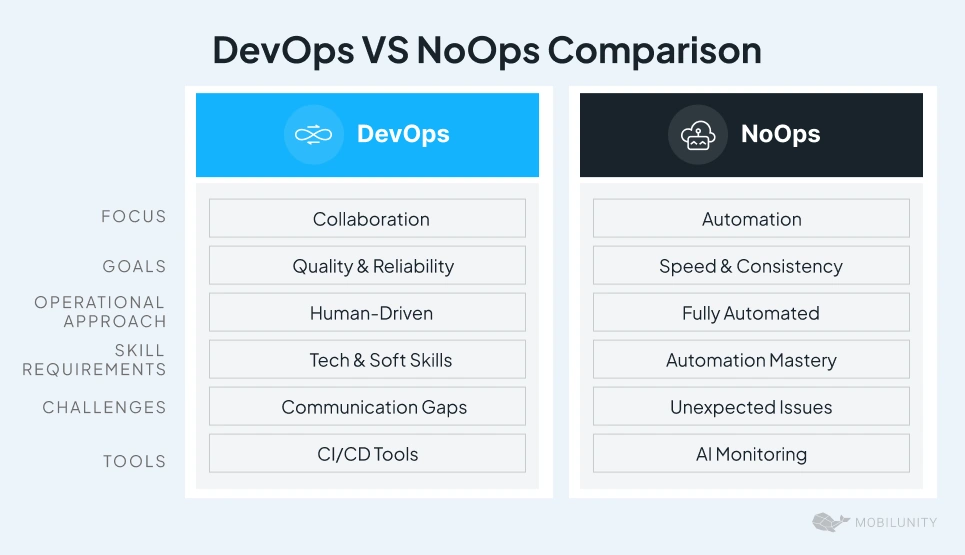
How NoOps Can Improve Operational Efficiency and Reduce Costs
By choosing the NoOps approach, you can achieve a lean, agile, and cost-effective IT environment that not only reduces overhead but also drives improved system performance and faster time-to-market. This strategic shift can enable the teams to focus on core innovation – rather than routine operations – ultimately providing a significant competitive advantage.
Key Benefits of NoOps – Operational Efficiency & Costs
Reduced Operational Overhead:
- Automates routine tasks such as provisioning, deployment, scaling, and monitoring
- Decreases the need for a large dedicated operations team, leading to lower costs
- Minimizes human error, resulting in fewer operational disruptions and faster issue resolution
- Streamlines workflows with automated pipelines, reducing the complexity of managing IT infrastructure.
Cost-Effectiveness through Serverless Computing:
- Utilizes serverless architectures (e.g., AWS Lambda, Azure Functions, Google Cloud Functions) where you only pay for compute time used
- Eliminates the cost of idle resources, as systems scale dynamically based on actual demand
- Reduces the need for upfront infrastructure investment and ongoing hardware maintenance
- Enables pay-as-you-go models that align operational costs directly with usage and traffic, optimizing budget allocation.
Efficiency Gains with Cloud Platforms:
- Uses cloud platforms that offer built-in scalability, redundancy, and maintenance, simplifying management and reducing downtime
- Automates infrastructure management using Infrastructure as Code (IaC) tools, ensuring consistent and error-free deployments
- Integrates advanced monitoring and logging systems to provide real-time performance insights, enabling proactive maintenance and rapid responses to issues
- Supports agile and iterative development, allowing teams to roll out new features quickly without disruption.
Can DevOps & NoOps Coexist within the Same Organization?
Is NoOps the end of DevOps? At first glance, DevOps and NoOps might seem mutually exclusive. However, in practice, they can coexist and even complement each other to address a wide range of operational needs.
Scenario 1
The management of large-scale applications that require both rapid deployments and continuous operational oversight. In such environments, DevOps teams can focus on strategic decision-making, complex problem-solving, and handling exceptions that automation alone might miss. Implementing NoOps practices for routine tasks like application deployment, infrastructure scaling, and basic monitoring. This hybrid model leads to the speed and cost-efficiency of automation – without sacrificing the critical human oversight needed for high-impact, unpredictable scenarios.
Scenario 2
Adopting a phased strategy – an organization might initiate projects with a DevOps framework to ensure thorough integration and robust testing when a system is still in its development phase. As the system becomes more stable, NoOps automation can be gradually introduced to take over routine operations such as deployments and scaling. This not only reduces operational overhead over time but also ensures a smooth transition to NoOps where the experienced DevOps team remains available to take action when needed. Such a phased approach ensures both agility and safety, making the best use of resources and reducing overall risk.
Challenges of Transitioning from DevOps to NoOps
Transitioning from DevOps to NoOps is a significant shift in software operations. That’s why projects with established DevOps practices may face several challenges during this transition, as listed below.
Over-Reliance on Automation
- Risk of System Failures. Excessive dependence on automation can lead to vulnerabilities, especially when unexpected issues arise that automated systems aren’t equipped to handle.
- Reduced Human Oversight. Critical thinking and nuanced decision-making, inherent to human operators, may be lacking in fully automated environments.
Complexity in Managing Automated Systems
- Integration Difficulties. Implementing and managing sophisticated automation tools can be complex, requiring specialized knowledge and training.
- Maintenance Challenges. Automated systems still require oversight to ensure they function correctly and adapt to changing requirements.
Security and Compliance Concerns
- Automated Vulnerabilities: Automated processes may inadvertently introduce security gaps if not properly configured and monitored.
- Regulatory Compliance: Ensuring that automated systems comply with industry regulations can be challenging without dedicated oversight.
Transition Challenges with Legacy Systems
- Incompatibility Issues. Legacy applications may not be compatible with modern automation tools, necessitating significant refactoring or replacement.
- Resource Intensive. Updating or replacing legacy systems to fit a NoOps model can be time-consuming and costly.
Cultural and Organizational Shifts
- Resistance to Change. Teams accustomed to DevOps practices may resist the transition to a NoOps model, fearing loss of control.
- Skill Gaps. Employees may require retraining to adapt to new tools and processes inherent in NoOps environments.
Summary
| Challenge | Specific Issues |
| Over-Reliance on Automation | System failures, reduced human oversight |
| Managing Automated Systems | Integration difficulties, maintenance challenges |
| Security and Compliance | Automated vulnerabilities, regulatory compliance |
| Legacy System Transition | Incompatibility issues, resource-intensive updates |
| Cultural and Organizational Shifts | Resistance to change, skill gaps among employees |
What Technologies Support the Implementation of NoOps?
To reach the necessary level of automation, NoOps relies on a variety of advanced technologies that work together to simplify infrastructure management, streamline deployments, and enable proactive system maintenance. Below are the key related technologies: serverless computing, microservices architectures, and AI-driven automation tools.
Serverless Architectures (Function-as-a-Service, FaaS)
AWS Lambda / Azure Functions / Google Cloud Functions
These platforms allow to run code without provisioning or managing servers. You pay only for the compute time that your functions actually use, leading to significant cost savings and operational efficiency.
Event-Driven Execution
Serverless platforms execute functions in response to events (e.g., HTTP requests, file uploads), which supports real-time processing without manual intervention.
Scalability and Flexibility
With auto-scaling built into serverless frameworks, your applications can seamlessly handle variable workloads while reducing the operational complexity associated with server maintenance.
Microservices Architectures
Containerization (Docker)
Container technologies package applications into lightweight, portable units. This simplifies deployment, ensures consistency across environments, and enables rapid scaling.
Orchestration Tools (Kubernetes, Docker Swarm)
These tools manage containerized applications, handling tasks like load balancing, scaling, and automated rollouts. This orchestration is critical for maintaining resilient, scalable systems in NoOps.
Service Meshes (Istio, Linkerd)
Service meshes facilitate reliable and secure inter-service communication within microservices architectures. They automate tasks like traffic management, service discovery, and security enforcement.
AI-Driven Automation Tools
Intelligent Monitoring and Analytics (Prometheus, Datadog)
AI-powered monitoring platforms continuously analyze system performance and user behavior to predict and mitigate potential issues before they become critical.
Automated Incident Response Tools (PagerDuty, Opsgenie)
These tools use machine learning algorithms to automatically manage alerts and coordinate responses, reducing the need for manual intervention during peak operational hours.
ChatOps and Bot Integration
Conversational interfaces and bots (e.g., using Slack integrations with custom AI agents) automate routine tasks and provide real-time insights, further reducing manual workload.
By combining serverless architectures, microservices, and AI-driven automation, NoOps creates an environment where IT operations are performed automatically, reliably, and at scale. For instance, serverless platforms handle routine compute tasks without manual intervention, while container orchestration ensures that microservices run consistently across environments. AI tools then continuously monitor these systems, predict failures, and adjust resource allocation dynamically.
Security Concerns When Adopting NoOps and Solutions
One of the primary security concerns in NoOps is the reliance on automated systems for critical processes such as deployment, monitoring, and incident response. Automation tools, while efficient, can be vulnerable if not configured correctly. Misconfigured automation scripts or incorrectly set up Infrastructure as Code (IaC) can lead to significant security loopholes. For instance, default configurations may leave sensitive information exposed, or automated processes might inadvertently grant excessive permissions, leading to privilege escalation. Additionally, these systems are typically integrated with multiple cloud services, and any security misstep in one service can compromise the entire environment.
Another significant risk is the potential for over-reliance on vendor-specific tools and cloud platforms. If you depend heavily on a single provider’s automation solutions, any vulnerabilities or breaches within that provider’s ecosystem can have a cascading effect on their operations. This vendor lock-in can limit flexibility and increase the risk if security updates or patches are not applied promptly by the vendor. Furthermore, the integration of multiple automated tools across different stages of the CI/CD pipeline introduces complexity, making it challenging to maintain a unified security strategy across the entire operational stack.
To mitigate these risks, we recommend adopting a multi-layered security strategy tailored for NoOps. This includes:
Configuration Management. Ensure that all automation scripts and IaC templates are thoroughly reviewed and follow best practices for security. Regular audits and automated compliance checks can identify misconfigurations early on.
Access Control and Least Privilege. Implement strict access controls to ensure that automated processes only have the minimum permissions necessary. Using role-based access control (RBAC) and regularly reviewing permission settings helps prevent unauthorized access.
Vendor Diversification and Due Diligence. Avoid over-reliance on a single automation platform or cloud provider. Diversify your tools and conduct regular security assessments of your vendors to ensure they meet your organizational security standards.
Continuous Monitoring and Incident Response. Integrate AI-driven monitoring systems that provide real-time security alerts and automated responses. Tools like Prometheus, Datadog, or cloud-native monitoring solutions can help detect anomalies and trigger corrective actions swiftly.
Regular Security Training and Updates. While NoOps minimizes intervention in daily operations, there should still be periodic training for the team overseeing the automation. Keeping abreast of the latest security trends, vulnerabilities, and best practices ensures that the human element remains prepared to intervene when necessary.
Penetration Testing and Vulnerability Scans. Periodically conduct comprehensive penetration tests and vulnerability assessments on the automated environments to identify and address potential weak points in your NoOps implementation.
Data Encryption and Secure Communication. Ensure that all data handled by automated systems is encrypted both in transit and at rest. Secure communication channels and up-to-date encryption protocols are critical in safeguarding sensitive information.
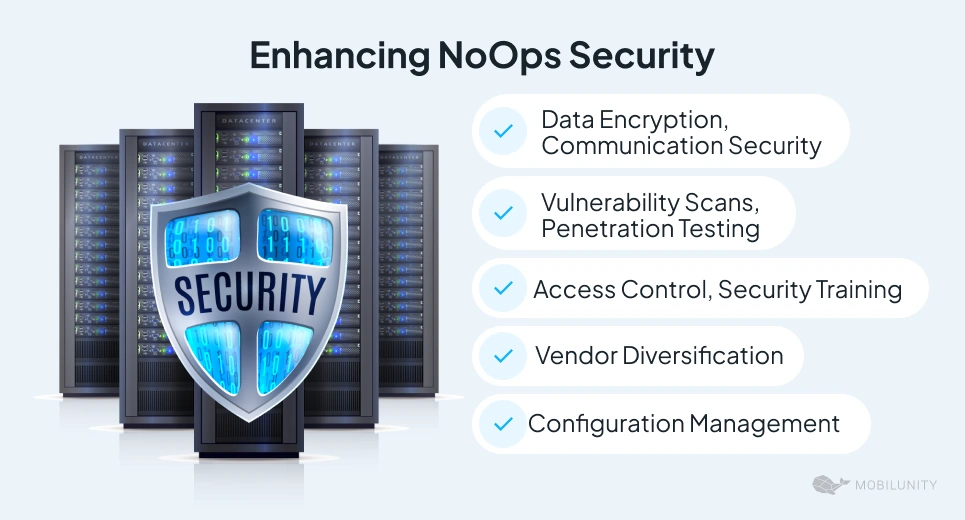
What’s The Future of NoOps in Software Development?
The future of NoOps appears both promising and transformative as technology continues to evolve. This shift is already being fueled by advances in cloud computing and the maturation of Infrastructure as Code (IaC), which together enable a more dynamic and resilient IT environment.
One of the key drivers in the evolution of NoOps is the integration of Artificial Intelligence. For example, AI-driven monitoring tools can continuously analyze system performance and predict potential failures before they occur, while machine learning algorithms can automatically optimize resource allocation in real-time. This means that as AI continues to improve, NoOps environments will become even more self-sufficient, capable of managing operational tasks with minimal human intervention. The result is a reduction in operational costs, faster deployment cycles, and fewer incidents of downtime that can disrupt business operations.
Modern cloud-native applications are also well-suited to a NoOps approach. The inherent scalability and on-demand nature of serverless computing platforms complement NoOps perfectly. This model not only reduces the need for manual intervention but also aligns IT costs directly with business activity. In turn, developers can focus on innovating and enhancing application functionality – rather than dealing with backend complexities.
Industry-specific use cases further highlight the potential of NoOps. In sectors like e-commerce, where customer experience is on top, fully automated IT environments can ensure that critical systems are always available and responsive, even during high-traffic events such as flash sales. In the Fintech industry, the need for rapid, automated compliance and data integrity checks also makes NoOps attractive. In media and entertainment, where real-time content delivery is essential, NoOps can easily facilitate rapid scaling and automated management of streaming services.
However, it’s important to note that while NoOps offers significant benefits, the transition is not without challenges. You must ensure that your automated systems are carefully configured, continuously monitored, and regularly updated. Remember that the reliance on advanced automation tools also necessitates robust security frameworks and contingency plans for potential failures. As the technology landscape evolves, a hybrid approach that combines the best aspects of NoOps with traditional DevOps practices may present the most practical solution for business.
